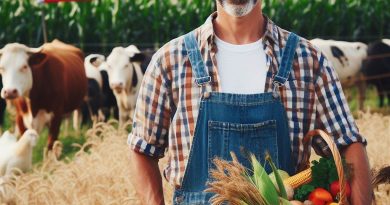Summertime’s Fresh Picks: Local Produce
Last Updated on March 2, 2024
Introduction
As the sun bathes the landscape in warmth, Summertime Fresh Local Produce emerges—a colorful celebration of nature’s bounty.
Ripe tomatoes, succulent berries, and crisp greens adorn the farmer’s market stalls.
The air is imbued with the promise of vibrant, seasonal flavors.
Supporting local farmers transcends mere consumerism; it’s a vital link to our community’s prosperity.
By choosing local produce, we foster a sustainable food ecosystem.
These fruits and vegetables, plucked at their peak, burst with nutrients, offering a direct path to wellness.
Amidst the sun-kissed days, the thesis comes into focus: Summertime’s fresh picks are not just about taste; they embody a commitment to health, community, and the environment.
Embracing the local harvest becomes a powerful act, shaping a season that nourishes both body and soul.
So, let the seasonal symphony of flavors inspire your plate, and let the sun-ripened fruits and veggies tell a story of sustainability and connection.
Overview of Local Produce
Local produce refers to fruits, vegetables, and other agricultural products that are grown or produced within a specific geographic region.
Advantages of consuming local produce
Consuming local produce has numerous advantages for individuals and communities:
- Superior freshness: Local produce is often picked at peak ripeness, offering better flavor and nutritional value.
- Supporting local farmers: Buying local produce helps sustain local agriculture and the families who depend on it.
- Reduced transportation: Since local produce doesn’t have to travel long distances, it reduces carbon emissions from transportation.
- Preservation of farmland: By supporting local produce, we contribute to the preservation of farmland and protect it from being developed.
- Seasonal eating: Local produce encourages a connection with nature and the enjoyment of fruits and vegetables in their natural seasons.
- Diverse varieties: Local farms often cultivate heirloom or lesser-known varieties, adding diversity to the food supply.
- Increased food safety: Local produce undergoes fewer handling and processing steps, reducing the risk of contamination.
- Community building: Farmers’ markets and farm-to-table initiatives connect people, fostering a sense of community and local pride.
The impact of local produce on the environment and the community
The impact of local produce on the environment and the community is significant:
- Reduced carbon footprint: Buying local means less energy is used for transportation, reducing greenhouse gas emissions.
- Preservation of natural resources: Local farming practices often prioritize sustainability, protecting soil, water, and wildlife habitats.
- Support for local economy: By buying local, we keep money circulating within the community, supporting local businesses and job creation.
- Food security: Relying on local produce strengthens food security, especially in times of natural disasters or global disruptions.
- Education and awareness: Local produce initiatives promote understanding of where our food comes from and the importance of healthy eating.
- Community resilience: When communities have access to local produce, they become more self-reliant and resilient in the face of challenges.
- Improved food quality: Local produce is often grown using sustainable and organic practices, resulting in higher-quality, healthier food.
- Cultural preservation: Local produce encourages the preservation of traditional farming practices, culinary heritage, and regional flavors.
By understanding what local produce represents, acknowledging its advantages, and recognizing its impact, we can make informed choices that benefit ourselves, our communities, and the environment.
Supporting local agriculture and embracing the bounty of seasonal offerings is a win-win for everyone involved.
So next time you have the chance, opt for those fresh local strawberries or carrots straight from your neighborhood farm!
Read: Seed Saving: Key for Sustainability
The Best Summertime Produce
Popular fruits in season during summertime
- Watermelon
- Strawberries
- Peaches
- Blueberries
- Raspberries
- Pineapple
Nutritional value and benefits of each fruit
- Watermelon: Rich in vitamins A and C, hydrating, helps with digestion and heart health.
- Strawberries: Packed with antioxidants, high in vitamin C, boosts immunity and promotes skin health.
- Peaches: Excellent source of vitamins A and C, aids digestion, supports healthy skin, and boosts immunity.
- Blueberries: Antioxidant powerhouse, high in fiber, improves brain function, and supports heart health.
- Raspberries: Loaded with antioxidants, high in fiber, promotes healthy weight loss, and may lower the risk of chronic diseases.
- Pineapple: High in vitamin C, bromelain for digestion, reduces inflammation, boosts immunity, and aids in eye health.
Ideas to incorporate these fruits into meals and snacks
When it comes to enjoying the best summertime produce, the options are endless. Here are a few delicious ideas:
Watermelon
- Make refreshing watermelon juice or smoothies.
- Create a colorful watermelon, feta, and mint salad.
- Grill watermelon slices and serve them with a sprinkle of sea salt.
Strawberries
- Blend strawberries into a morning smoothie or fruit yogurt.
- Toss them into salads for a burst of sweetness.
- Dip strawberries in dark chocolate for a healthy dessert option.
3. Peaches
- Enjoy fresh peaches on their own as a juicy snack.
- Slice peaches over oatmeal or cereal for a flavorful breakfast.
- Create a peach salsa to pair with grilled chicken or fish.
Blueberries
- Sprinkle blueberries into pancakes or waffles for a nutritious twist.
- Add them to salads or yogurt parfaits for an antioxidant boost.
- Bake them into muffins or desserts for a sweet treat.
Raspberries
- Mix raspberries into your favorite yogurt for added flavor and texture.
- Blend them into a creamy raspberry sorbet or ice cream.
- Create a refreshing raspberry vinaigrette for salads.
Pineapple
- Grill pineapple slices and serve them as a side dish to grilled meat or fish.
- Add pineapple chunks to stir-fries for a tropical twist.
- Create a pineapple salsa to accompany tacos or grilled shrimp.
By incorporating these delicious fruits into your meals and snacks, you’ll not only enjoy their wonderful flavors but also reap their numerous health benefits.
Happy summer eating!
Read: Local Food Trends: From Farmer’s Field to You

Abundance of Fresh Vegetables
Variety of vegetables available during summertime
- Tomatoes
- Cucumbers
- Peppers
- Zucchini
- Carrots
- Eggplant
- Corn
- Squash
- Green beans
- Spinach
Summertime brings a colorful array of fresh vegetables, perfect for a healthy and vibrant diet.
These vegetables are not only delicious but also full of essential nutrients.
Nutritional benefits of consuming fresh vegetables
Consuming fresh vegetables is important for maintaining good health and providing vital nutrients for our bodies.
Some benefits include:
- High in vitamins and minerals
- Rich in fiber, aiding in digestion
- Low in calories and fat
- Contain antioxidants, protecting against diseases
- Boost the immune system
- Promote healthy skin and hair
- Improve overall energy levels
Including a variety of fresh vegetables in your diet can help prevent chronic diseases and promote overall well-being.
Share tips on how to select, store, and prepare the featured vegetables
Choosing the best vegetables and knowing how to store and prepare them properly ensures maximum flavor and nutritional value.
Here are some tips:
Selecting
- Look for brightly colored vegetables with firm texture
- Avoid any signs of wilting or bruising
- Opt for organic options when possible to avoid pesticides
Storing
- Store vegetables in a cool and dry place, such as the refrigerator
- Keep them separate from fruits to prevent ethylene gas exposure
- Use airtight containers or bags to maintain freshness
Preparing
- Wash vegetables thoroughly before consuming
- Peel or chop as necessary for the chosen recipe
- Try roasting, steaming, or sautéing them to retain nutrients and enhance flavors
- Experiment with different seasonings and herbs for added taste
- Enjoy raw in salads or as crunchy snacks for a refreshing option
By following these tips, you can make the most of the variety of fresh vegetables available during summertime.
Read: Organic Foods: Beyond the Hype
You Might Also Like: Autumn Harvest: What to Eat This Fall
Supporting Local Farmers
Importance of supporting local farmers and their businesses
Supporting local farmers is crucial for the sustainability of our communities.
By purchasing their produce, we directly contribute to the growth of small-scale agriculture.
This support allows farmers to stay in business and continue providing fresh, high-quality produce.
Furthermore, local farmers play a significant role in preserving biodiversity.
They often cultivate heirloom varieties and rare crops that are not found in large-scale industrial agriculture.
By supporting them, we help protect these unique species from extinction.
How buying local produce contributes to the local economy
When we buy local produce, we are investing in our own community.
Local farmers keep a large portion of their earnings within the local economy, creating a ripple effect of economic growth.
They hire local labor, invest in local infrastructure, and support other local businesses.
Moreover, buying local produce helps to reduce transportation costs and energy consumption.
Since the produce doesn’t have to travel long distances, it saves fuel and decreases the carbon footprint associated with transportation.
This reduction in environmental impact benefits not only our local area but the planet as a whole.
Ways readers can support local farmers, such as visiting farmers markets or joining a Community Supported Agriculture (CSA) program
One of the best ways to support local farmers is by visiting farmers markets.
These vibrant spaces not only offer fresh produce but also allow direct interaction with farmers.
By engaging in conversations, we can learn more about their farming practices and develop a deeper connection to the food we consume.
Joining a CSA program is another fantastic way to support local farmers. In a CSA, individuals purchase a share of a farm’s harvest in advance and receive a box of fresh produce regularly.
This system not only provides financial support to farmers but also guarantees consumers a consistent supply of seasonal, locally grown fruits and vegetables.
Other ways to support local farmers include dining at farm-to-table restaurants, participating in community gardens, and volunteering at local farms.
These activities strengthen the bond between consumers and producers, fostering a sense of food security and community resilience.
In general, supporting local farmers is essential for the vitality of our communities.
By purchasing their produce, we contribute to the local economy, protect biodiversity, and reduce our environmental impact.
So let’s make an effort to visit farmers markets, join CSA programs, and engage in activities that connect us with the farmers who work hard to provide us with fresh, delicious food.
Read: Philly Farm-to-Table Culinary Stars
How to Find and Buy Local Produce
To support your local community and enjoy fresh produce
here are some ways to find local sources
- Visit farmers markets in your area. These markets are usually held weekly and offer a wide selection of locally grown fruits, vegetables, and other products.
- Explore farm stands or roadside stands. Many local farmers set up stands near their farms to sell their fresh produce directly to consumers.
- Consider joining Community Supported Agriculture (CSA) programs. CSA programs allow you to subscribe to a farm and receive a share of their harvest on a regular basis.
Utilize online resources to discover nearby local farms and markets
- Check out websites dedicated to promoting local farms and farmers markets in your area. These websites often provide information on locations, available produce, and operating hours.
- Use smartphone applications specifically designed to connect consumers with local farmers. These apps can help you discover nearby farms, read reviews, and even place orders for pickup or delivery.
- Follow social media accounts of local farms and farmers markets. Many of them post updates about their products, upcoming events, and special offers.
Ensure you select the freshest produce and inquire about farming practices
- Look for the signs of freshness, such as vibrant colors, firm texture, and a pleasant aroma. Avoid produce with bruises, blemishes, or signs of decay.
- Ask farmers or vendors about their farming practices. Inquire if they use organic methods, avoid pesticides, or follow sustainable farming practices. This way, you can make informed choices.
- Pay attention to food labels and certifications. Look for labels like “Certified Organic” or “Grown Locally” to ensure the produce meets specific quality standards.
- Engage in conversations with farmers or vendors. They can provide helpful insights, recommend their best produce, and even share recipe ideas.
By following these guidelines, you can easily find and buy local produce, supporting local farmers and enjoying the best flavors nature has to offer.
Conclusion
Summertime’s vibrancy extends beyond sun-soaked days. Embrace the season’s culinary gifts by choosing local produce.
Their freshness not only tantalizes the taste buds but also packs a nutritional punch, enhancing your overall well-being.
Supporting local farmers isn’t just a transaction; it’s an investment in your community.
These hardworking individuals contribute to the local economy, fostering resilience and sustainability.
By choosing their products, you become a vital part of a chain that strengthens the very fabric of your neighborhood.
Let your taste buds embark on a local journey. Experience the vibrant flavors and textures only found in nearby fields.
As you savor each bite, recognize the impact of your choice—supporting local businesses, reducing your carbon footprint, and indulging in food at the peak of its freshness.
In your culinary adventures, make conscious choices.
Cultivate a mindful approach to food consumption, appreciating not only the deliciousness on your plate but also the interconnected web of farmers, communities, and ecosystems that thrive when you choose local.
Together, let’s savor the essence of summertime through the bountiful and nourishing offerings of local produce.


